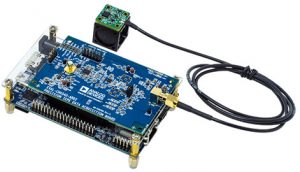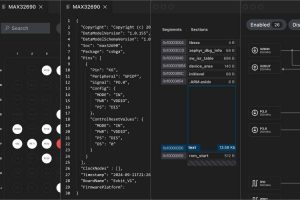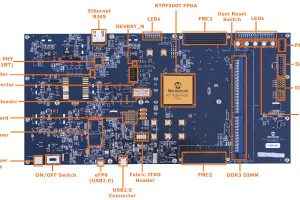
Called CN0549, its hardware includes a dc – 10kHz MEMS vibration sensor board (see photo), a characterised mounting cube for the sensor, a data acquisition system reference design (top board) and an embedded gateway/processing board (bottom PCB).
 Communication between the sensor and data acquisition boards is over an IEPE compliant interface.
Communication between the sensor and data acquisition boards is over an IEPE compliant interface.
With the kit, you can “stream vibration data into popular machine learning environments such as Matlab, TensorFlow, and other Python based tools for algorithm development using step-by-step examples”, according to the company.
The individual parts are:
- EVAL-CN0532-EBZ MEMS accelerometer
- EVAL-XLMOUNT1 mounting block
- EVAL-CN0540-ARDZ 24bit data acquisition board
- DE10-Nano FPGA board (Cyclone V chip)
For a Zync-7000 instead of a Cyclone V, the Cora Z7-07s board can be used
IEPE is ‘integrated electronic piezoelectric’, a standard with two wires, one of which is ground. The acquisition card supplies power to the sensor via the signal line, which is modulated by the sensor to return information.
ADI is pitching this system against piezo sensors – the kit allows piezo sensors to be swapped in for the MEMS sensor.
“Piezo accelerometers dominate the market today because of their wide-band frequency response and sensitivity to vibration stimuli, ” said the company. “However, with recent advancements with MEMS technology, piezos and MEMS accelerometers are closer in performance than ever before. CN-0532 vibration sensor is based on the ADXL1002. Noise and bandwidth is comparable with a piezoelectric sensor while the ADXL1002 provides superior performance in temperature sensitivity, dc to low frequency response, phase response – and thus, group delay, shock tolerance and shock recovery.”
The mounting cube is not trivial. This one works up to 20kHz, and is anodised to prevent short circuits.
“Getting dependable sensor data from the machine being monitored into the processor is challenging. First a connection between the sensor and the equipment being monitored must be established. It is important to ensure that the vibration spectrum is not altered by any mechanical effects due to the mounting. The five-sided mounting cube allows a user to attach CN-0532 to equipment without any sensor degradation to data,” said ADI.
 Electronics Weekly
Electronics Weekly



